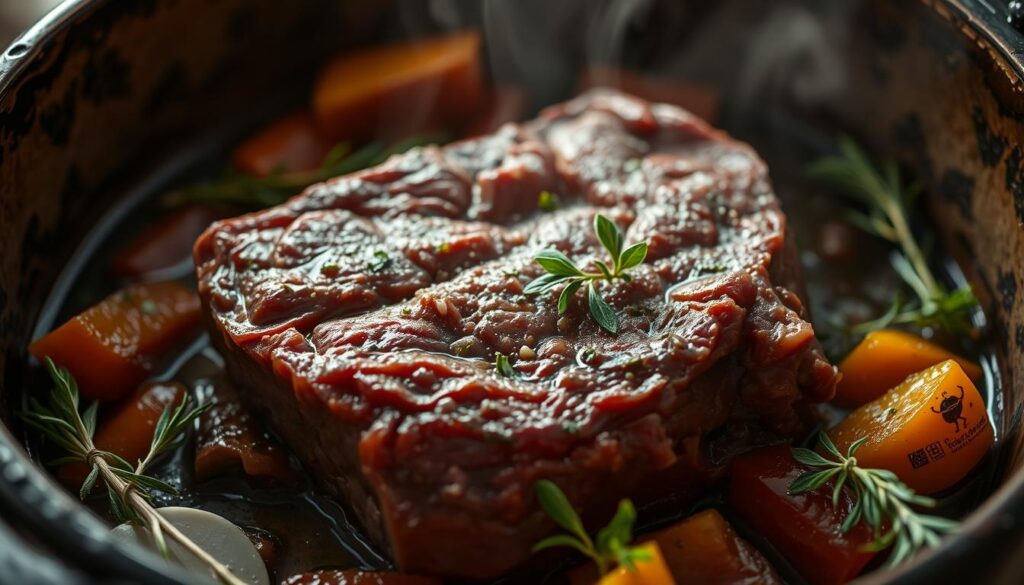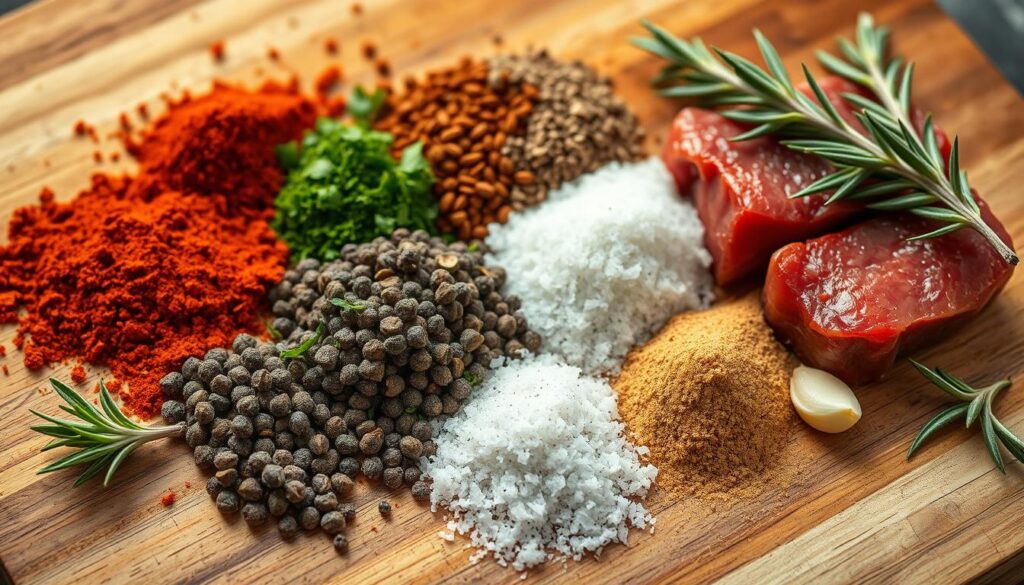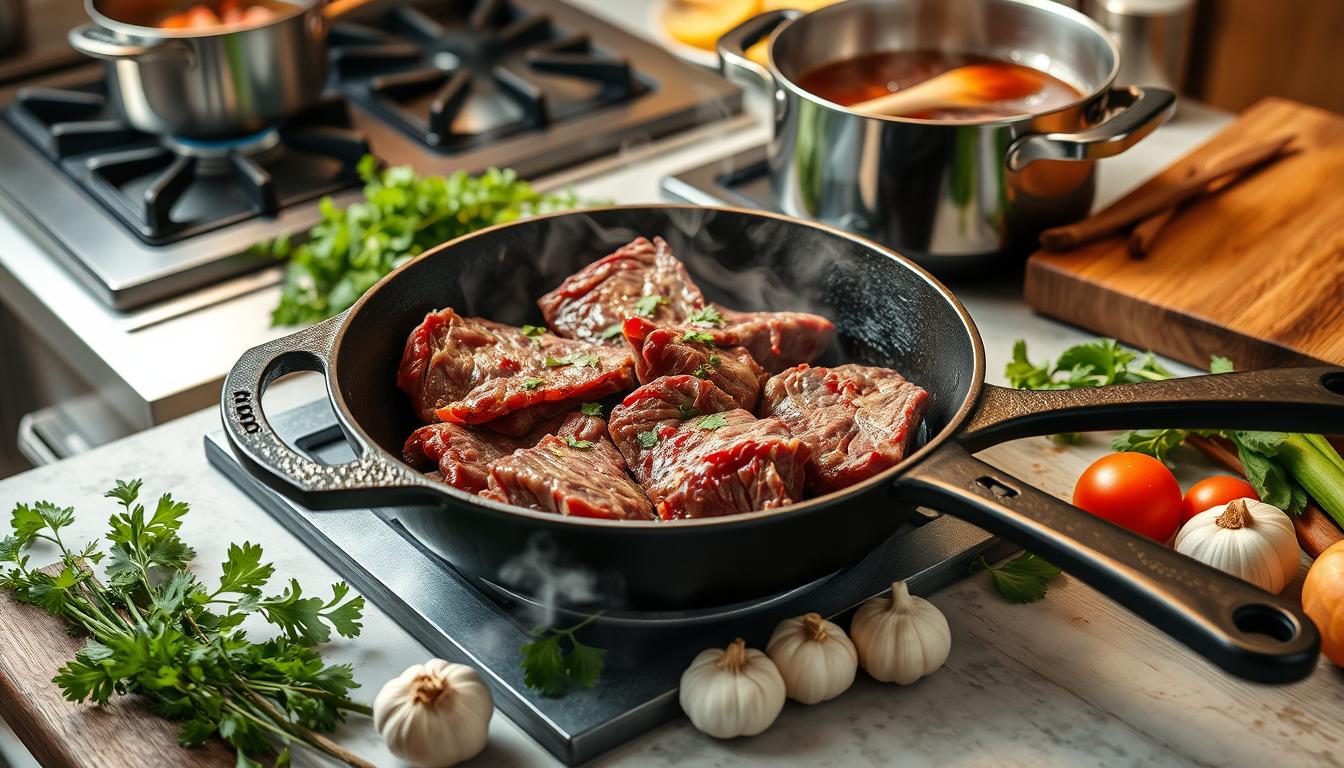Ever wonder how chefs make tough beef cheek meat tender? Cooking beef cheek meat is an art. It can make you go from beginner to pro in a few steps.
Beef cheek meat is a hidden treasure in cooking. It needs patience and special cooking ways to be tender and tasty. When done right, it’s tender, flavorful, and hard to resist.
This guide will teach you how to cook beef cheek meat like a pro. You’ll learn how to pick the best cut and use slow-cooking techniques. You’ll discover how to turn this simple ingredient into a dish fit for a restaurant.
Key Takeaways
- Beef cheek meat needs slow cooking to be tender
- Proper searing is key for deep flavors
- Braising is the best way to cook beef cheeks
- Patience is important when cooking this special meat
- Knowing how to control temperature and moisture is crucial for great results
Understanding Beef Cheek Meat
Beef cheek meat is a hidden gem in cooking. It starts tough but becomes a delicious treat. You’ll be amazed by its unique taste and how it shines in beef cheek meat recipes.
What Makes Beef Cheeks Special?
Beef cheeks are the jaw muscles of cattle. They work hard all their lives. This makes the meat tough but full of flavor.
In the U.S., they’re called cheek meat. In the U.K., they’re known as ox cheeks.
The Slow Cooking Magic
These muscles need slow cooking to become tender. The slow cooking breaks down the tough parts. This turns the meat into a soft, tasty treat.
| Nutritional Content | Per 100g |
|---|---|
| Energy | 250 kcal |
| Protein | 26 g |
| Fat | 15 g |
| Carbohydrates | 0 g |
Nutritional Powerhouse
Beef cheeks are not just tasty. They’re also packed with nutrients. They have lots of protein and very few carbs. This makes them great for those who care about their health.
“Beef cheeks prove that with the right technique, every cut of meat can become a culinary masterpiece.” – Professional Chef
- Best cooking method: Slow cooking (5-6 hours)
- Average weight per cheek: 8-16 ounces
- Recommended serving: One cheek (approximately 6 ounces)
Essential Equipment and Ingredients for Perfect Beef Cheeks
To make beef cheek meat recipes, you need a few tools and ingredients. These will turn a tough cut into a delicious meal. Start by picking the right equipment and ingredients to make your cooking better.
Essential Kitchen Equipment
- Large Dutch oven or heavy-bottomed pot
- Sharp chef’s knife
- Cutting board
- Slow cooker (optional but recommended)
- Meat thermometer
When looking for beef cheeks, you might need to ask your butcher. Specialty meat markets usually have this special cut. It’s great for slow cooking.
Key Ingredients for Beef Cheek Recipes
| Ingredient | Purpose | Quantity |
|---|---|---|
| Beef Cheeks | Primary protein | 2-3 lbs |
| Kosher Salt | Base seasoning | 2 tbsp |
| Black Pepper | Spice enhancement | 1 tbsp |
| Garlic Powder | Flavor depth | 1 tsp |
| Smoked Paprika | Smoky undertones | 1 tsp |
Pro tip: The secret to tender beef cheek meat recipes lies in patience and low, slow cooking techniques.
Your kitchen is now ready to make these beef cheeks into a dish that will wow everyone. Remember, the right tools and ingredients are your first step toward culinary success!
Preparing Your Beef Cheek Meat for Cooking
Getting ready to cook beef cheek meat needs careful steps. These cuts need attention to become a tasty dish. Learning how to cook them starts with the right prep to bring out their flavor and tenderness.
Trimming and Cleaning Tips
Begin by removing extra fat and connective tissue from the beef cheek meat. Use a sharp knife to cut away any tough parts. This makes a clean cut that soaks up seasonings well.
- Remove silver skin carefully
- Trim visible fat to about 1/4 inch thickness
- Pat meat dry with paper towels
Seasoning and Marination Techniques
“The secret to incredible beef cheeks is in the seasoning!” – Professional Chefs
Learning to cook beef cheek meat means making it taste great. First, coat the meat with good olive oil. Then, add a mix of seasonings:
- Coarse salt (1 tablespoon)
- Fresh ground black pepper (1 tablespoon)
- Ground cumin (1 teaspoon)
- Optional herbs like thyme or rosemary
Pre-cooking Preparation Steps
After seasoning, wrap the beef cheeks in aluminum foil and chill. Marinate for 4 hours to overnight. This lets the meat soak up flavors well.
Pro tip: Always bring meat to room temperature before cooking to ensure even heat distribution.
Slow Cooking Methods and Temperatures
Learning to cook beef cheek meat is all about slow cooking. These tough cuts become tender and delicious with patience and care.

When smoking beef cheek meat, keeping the temperature right is key. Chefs say to keep it between 225°F and 250°F for the best taste.
Recommended Cooking Methods
- Slow Cooker: 8-10 hours on LOW setting
- Oven Braising: 300°F for 6-8 hours
- Smoker: 225°F-250°F for approximately 3 hours
Each way has its own steps, but the goal is the same. You want meat that’s tender and full of flavor.
| Cooking Method | Temperature | Cooking Time | Target Internal Temp |
|---|---|---|---|
| Slow Cooker | LOW (200°F) | 8-10 hours | 205°F |
| Oven Braising | 300°F | 6-8 hours | 205°F |
| Smoker | 225°F-250°F | 3 hours | 205°F |
The key to perfect beef cheeks is patience: low temperatures transform tough muscle into tender, succulent meat.
Pro tip for how to cook beef cheek meat: Always let the meat rest after cooking. This makes the meat juicy and full of flavor.
Remember, whether smoking or using a slow cooker, keep the temperature steady. You’ll get meat that’s so tender, it almost melts in your mouth.
Braising Techniques for Maximum Tenderness
Learning to cook beef cheek meat is all about braising. This method makes tough meat soft and delicious. It’s a skill that will wow your guests.
The Perfect Searing Process
Searing is the first step in cooking beef cheek meat. It makes a golden crust that keeps flavors in. Here’s how to do it:
- Pat the beef cheeks dry with paper towels
- Season with sea salt and black pepper
- Heat rapeseed oil in a heavy pan until it smokes
- Sear each side for 2-3 minutes until it’s dark golden
Liquid Ratios and Timing Mastery
Choosing the right liquid is crucial for tender beef cheek meat. The right cooking liquid can make your dish amazing.
| Liquid Type | Quantity | Cooking Impact |
|---|---|---|
| Veal Stock | 500 ml | Rich, deep flavor |
| Red Wine | 75 cl | Adds complexity |
Temperature Control Techniques
Keeping the right temperature is key for tender beef cheeks. Cook at a low heat:
- Cooking temperature: 160°C (gas mark 3)
- Total cooking time: 3-4 hours
- Turn meat every 20-30 minutes
- Aim for fork-tender texture
Pro tip: Patience is the secret ingredient in creating perfectly braised beef cheeks.
By following these techniques, you’ll transform tough beef cheeks into a restaurant-quality dish that’s sure to impress.
Flavor Variations and Seasoning Combinations
Beef cheek meat recipes need creativity and flavor knowledge. The right seasonings can make these cuts into amazing dishes. They will wow even the pickiest eaters.

- Classic Smoked: Salt, pepper, garlic powder, paprika
- Mexican-Style Barbacoa: Cumin, chili powder, oregano, lime juice
- Coffee-Rubbed: Ground coffee, brown sugar, smoked paprika
- Sweet and Smoky: Chipotle powder, maple syrup, black pepper
- Chimichurri-Inspired: Fresh herbs, red wine vinegar, garlic
Here are some pro tips for beef cheek meat recipes:
- Marinate overnight for the best flavor
- Use both dry and wet seasonings
- Balance heat with sweet or acidic
- Try different spice mixes from around the world
“The secret to incredible beef cheeks is layering flavors and allowing enough time for seasoning to work its magic.” – Professional Chef
Your cooking temperature is key for flavor. Smoke at 225-250°F and cook to 200°F for tenderness. Patience makes great beef cheek recipes even better.
Serving Suggestions and Side Dish Pairings
Make your beef cheek meat recipes special by choosing the right sides. The meat is tender and rich. It needs sides that match its flavors and feel.
Traditional Accompaniments
Classic sides can make your beef cheek meat recipes unforgettable. Here are some old favorites:
- Creamy mashed potatoes
- Roasted root vegetables
- Buttered egg noodles
- Polenta with parmesan
Modern Plating Ideas
Try new things for a fresh look. Here are some modern ideas:
- Cauliflower puree – A light mash option
- Cauliflower rice for a low-carb choice
- Honey-glazed carrots
- Roasted asparagus with garlic
Wine Pairing Recommendations
The right wine can make your dish even better. Here’s a quick guide:
| Wine Type | Flavor Profile | Best Pairing |
|---|---|---|
| Cabernet Sauvignon | Bold, full-bodied | Perfectly complements rich beef cheeks |
| Malbec | Robust, spicy | Matches the meat’s intense flavor |
| Syrah | Dark fruit notes | Enhances the dish’s complexity |
“The art of serving is not just about the food, but the experience you create around it.” – Culinary Experts
For a meal you’ll remember, mix flavors, textures, and how it looks. Your beef cheek recipes will stand out with the right sides and presentation.
Conclusion
Learning to cook beef cheek meat makes it a fancy dish. You now know how to turn this tough cut into a soft, tasty treat. You’ve learned how to cook it slowly to make it tender and full of flavor.
Preparing beef cheek meat takes time and care. By cooking it low and slow, and using the right spices, you can make it taste amazing. A delicious beef recipe is now easy to make. It will make your meals unforgettable and impress everyone.
Beef cheek meat is not just tasty, it’s also very good for you. It’s full of protein, zinc, and vitamins. Whether you make tacos or a slow-cooked dish, you’ll get better at cooking. And you’ll learn to love this special cut of meat.
FAQ
What exactly are beef cheeks?
Beef cheeks are the muscles of a cow’s face. They move a lot. This makes them tough when raw.
But, they’re perfect for slow cooking. It makes them tender and flavorful.
Why are beef cheeks more expensive than other cuts of meat?
Beef cheeks are tough but full of flavor. They become tender when cooked slowly. This makes them special.
They’re small and not made in big amounts. This is why they cost more. Chefs and home cooks love them for their taste and texture.
How long do beef cheeks need to be cooked?
Beef cheeks need to cook for 3-4 hours. This is when you braise them in the oven or slow cooker.
Low and slow cooking is key. It makes the meat tender. Cook at 325°F for the best results.
Can I substitute beef cheeks with another cut of meat?
You can use other tough cuts like chuck roast or short ribs. But, they won’t taste the same as beef cheeks.
Beef cheeks have a unique flavor and texture. They’re special.
Where can I buy beef cheeks?
You might not find beef cheeks everywhere. Look at specialty butcher shops, local meat markets, and some high-end grocery stores.
Online meat suppliers also carry them. If you can’t find them, ask your butcher to order them for you.
Are beef cheeks a healthy meat option?
Yes, beef cheeks are nutritious. They’re full of protein, vitamins like B12, and minerals like zinc and iron.
They have some fat, but they’re good for you in small amounts. They’re part of a healthy diet.
What are the best ways to cook beef cheeks?
The best ways are braising, slow cooking, and smoking. These methods cook them low and slow.
This makes the meat tender and flavorful. Braising in wine or broth, or using a Dutch oven or slow cooker, works well. Smoking is also great.
How should I store cooked beef cheeks?
Store cooked beef cheeks in an airtight container in the fridge for 3-4 days. You can freeze them for up to 3 months.
When reheating, do it slowly. Add a bit of liquid to keep the meat moist.


1 thought on “How to Cook Tender Beef Cheek Meat Like a Pro”
Comments are closed.